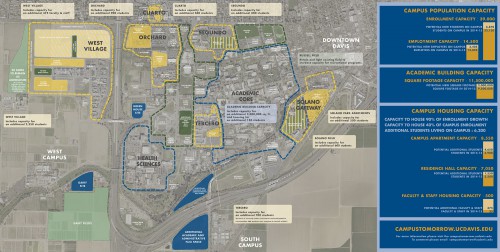
While, last week, UC Davis laid out what appeared to be its final LRDP (Long Range Development Plan) proposal before going to the EIR process, the city has put an item on the agenda urging changes to UC Davis’ 10 year LRDP.
Currently, the Draft LRDP identifies growth projections of adding 6,870 students and 2,405 new employees, along with a map identifying areas of where this growth could potentially be accommodated. In a critical win for activists and residents, Bob Segar, the Assistant Vice Chancellor, announced that the university was withdrawing its plans to build student housing (or any building) on the athletic fields along Russell Boulevard.
However, the current scenario projects accommodating on-campus housing for 90 percent of new student enrollment and 40 percent of the total student population.
Staff writes, “Given the proximity of campus to the City of Davis and the seamless boundaries that exist in many areas, the City desires to inform discussion with campus on how best to accommodate growth in a manner that sustains the quality of life for residents and businesses. Recognizing that land use and policy decisions for campus are made by the UC Board of Regents, it is of critical importance that the ultimate growth plan adopted for UC Davis is respectful of and compatible with the vision of the City.”
The city council appointed an LRDP council subcommittee “to engage with campus to articulate City interests with the goal of informing future campus decisions. The Council subcommittee (Robb Davis and Rochelle Swanson) and staff have been actively discussing key issues of interest with campus, inclusive of issues identified internally and those raised by constituents.”
Following the meeting last week, the subcommittee “re-convened and determined that it would be prudent to prepare a draft City Council Resolution and transmittal letter to be considered by the full City Council on a more accelerated schedule so as to afford the opportunity to gain Council consensus on fundamental issues of interest and to clearly communicate those issues to UC Davis in advance of their release of an EIR Notice of Preparation.”
A draft resolution includes some key provisos:
“The City has been and remains committed to doing its part to provide for the full and diverse breadth of housing needs in our community, including, but not limited to seniors, affordable housing, accessible housing, workforce housing, families, as well as student oriented housing.
“The City is also committed to reviewing new high density apartment proposals, as they come forward.
“Although the initial attempt at the ballot did not prove successful, the City Council remains committed to working with the property owner and UC Davis to determine the future possibilities for the Nishi site.
“With the City’s continuous consideration of proposals to meet the wide range of community housing needs, it is crucial to recognize that the role of the City in the provision of housing fundamentally differs from that of the University. Where the City reviews proposals for development of private property and does not ultimately control where and when those proposals will be made to the City, the University of California controls its own fate of on-campus growth, construction, funding, and the timing thereof.”
The council also notes that “in 1989 the City and UC Davis developed a Memorandum of Understanding (MOU) wherein UC Davis and the City agreed that ‘it is in their mutual interests to plan and phase campus and City growth’ and that ‘sharp student enrollment increases should be avoided in favor of more gradual and planned growth.’”
While enrollment has risen steadily, it now is planned to “to rise sharply, while new on-campus student housing construction, and planned on-campus housing development has not kept pace.”
The city is critical here, noting, “past MOUs between the City and UC Davis have not resulted in the desired delivery of needed housing, campus housing development has not kept pace with prior agreements and the City wishes to explore partnership framework opportunities with UC Davis to develop a mechanism by which LRDP and City residential and non-residential space needs and commitments can be achieved and monitored over time.”
The city council authorized the mayor to transmit the following requests in a letter to UC Davis:
- That UC Davis provide for a minimum of 100 percent of the projected enrollment of all new incoming students starting with the 2017 academic year and at least 50 percent of total UC Davis campus student population in the LRDP.
- That UC Davis provide clear definition of non-residential space expansion needs and how those needs will be accommodated on-campus in the LRDP.
- That UC Davis develop a construction and financing implementation strategy to accompany the LRDP to ensure the delivery of these units and facilities in a timely manner.
- That absent the on-campus housing increase and delivery strategy noted above that UC Davis work with the UC Regents to reduce the UC Davis enrollment growth allocation or timing thereof.
- That UC Davis withhold the impending release of the LRDP and EIR Notice of Preparation to provide the opportunity for UC Davis to appropriately consider and integrate the City’s requests.
- That UC Davis work with the City in parallel with the LRDP to develop a framework for a partnership that recognizes our mutual needs, as well as limitations in the face of the anticipated growth at UC Davis over the coming decade, and how both entities can best support one another and ensure desired outcomes with ongoing monitoring.
—David M. Greenwald reporting






Surprised to see no comments here.
I want to respond to the recommendations……….
That UC Davis provide for a minimum of 100 percent of the projected enrollment of all new incoming students starting with the 2017 academic year and at least 50 percent of total UC Davis campus student population in the LRDP.
Why is the city pushing 100/50? For all of the talk about the university, the city has hardly added any student housing in the last decade even as the university grew and vacancy rates shrank
That UC Davis provide clear definition of non-residential space expansion needs and how those needs will be accommodated on-campus in the LRDP.
This one I don’t get – please explain Robb Davis
That UC Davis develop a construction and financing implementation strategy to accompany the LRDP to ensure the delivery of these units and facilities in a timely manner.
Ok
That absent the on-campus housing increase and delivery strategy noted above that UC Davis work with the UC Regents to reduce the UC Davis enrollment growth allocation or timing thereof.
Right. That’s not going to happen.
That UC Davis withhold the impending release of the LRDP and EIR Notice of Preparation to provide the opportunity for UC Davis to appropriately consider and integrate the City’s requests.
Why didn’t the city do this in June instead of right as the university is going to EIR?
That UC Davis work with the City in parallel with the LRDP to develop a framework for a partnership that recognizes our mutual needs, as well as limitations in the face of the anticipated growth at UC Davis over the coming decade, and how both entities can best support one another and ensure desired outcomes with ongoing monitoring.
Fine, but again, wishful thinking.
This has to do with the much-discussed reality that when the University purchases or leases property in the City, the City looses property tax revenue. We are not talking here about UCD spinoff companies, which is addressed elsewhere, but rather University-occupied spaces. Since we do not have in place any kind of agreement with UCD concerning “make-whole” provisions, we are merely asking them to help us understand their non-residential (office, or other) space needs and how they plan to meet them. This is an important issue.
For the rest… we approach this in the spirit of making sure we ask for what we believe is in our interests. I have absolutely no problem doing that and have done so in all my interactions with University leadership. I encourage you to read the staff report to learn more about what Davis has done in relation to housing. I make no apologies for the decisions in which I have participated (in relation to housing in the City) since I started on the CC.
The University leases a number of commercial buildings in town for various departments’ use. This is likely a bigger financial hit for the City (loss of property tax) than is the model lease issue. With commercial buildings, property tax is collected on both the ‘real’ property (land and buildings) and the unsecured property (equipment, machinery etc.) inside. If we were focused on maximizing City revenues, getting the University to commit to building more research and office space on campus (and vacating the leased properties in the City) would be much more important than adding on-campus housing. In fact, from a fiscal perspective, the CC should probably ignore the on-campus housing issue entirely and focus exclusively on the commercial space.
I just wanted to respond to a few of the questions and points raised by Chamber Fan and Mark West. Given the late hour I don’t have time to address everything.
Why 50% of students housed on campus? This goal would put UCD on par with the current LRDPs at other UC campuses, and/or LRDP revisions under way. Given the massive recent growth resulting from UCD’s self-imposed (i.e., not mandated by UCOP) “2020 Initiative” and the additional growth contemplated in the LRDP, housing only 40% of total enrollment on campus will nonetheless result in a higher number of students seeking rental housing in Davis and beyond. Keep in mind that according to UCD’s own data, 10% of students are now driving to campus from towns such as Woodland, whose residents have complained to Assemblyman Dodd about the impacts of more students living in their town. And, as Interim Chancellor Hexter said to the Regents in November, having that many students commute to campus works against the university’s climate and sustainability goals.
Non-Residential Space: This probably results from UCD’s recent attempt to buy the University Research Park, for an amount in the mid $60 million range. If UCD’s bid had been successful, it would have deprived the City of literally hundreds of thousands of dollars of property taxes annually. I think the proposed Council resolution is aiming to preclude another unexpected action like that in the future; in my view, a very prudent move by the LRDP subcommittee comprised of Mayor Davis and Councilmember Swanson.
Reducing campus enrollment growth if these measures don’t occur: Well, yes, that can indeed happen. A citizens group successfully sued UC Santa Cruz because the enrollment growth was overwhelming the town. (The resididents of SLO are complaining about the same thing.) The result was a Comprehensive Settlement Agreement whereby UCSC will curtail enrollment growth whenever the percentage of students housed on campus is likely to drop below 50%. The agreement was executed among the citizens group, the City of Santa Cruz, the university and the Board of Regents. I believe UCSC is currently moving portable residential units into a parking lot as an interim measure while construction is completed on new campus apartments. This clause in the proposed resolution is prudent, and again one for which Robb and Rochelle (along with City staff) should be congratulated for their foresight. Another thought: Except for Santa Cruz, Davis has the smallest population of any UC host city. According to UCD stats, there’s almost 35,000 students on campus this fall. And, according to State of CA Dept of Finance, there was just about 68,000 people were living in Davis in January 2016. That means the number of students is more than half of the town’s population. That’s a very high ratio that should not increase. The town simply does not have the resources or infrastructure to continue absorbing more students.
Delaying the EIR until the LRDP is amended: The CC LRDP subcommittee was not even appointed until the summer, and it understandably took them awhile to get up to speed on the issues and to accumulate data. As noted in the December 6 staff report, the subcom and staff held numerous meetings with UCD over the ensuing months. This is a complex public policy issue that has many intricate moving parts. I personally think the CC subcommittee got a lot done in a short period. The council is again wise and prudent asking for a delay in launching of the CEQA Initial Study (IS) until the City gets what it is seeking; that is, changing the 40/90 equation to 50/100. CEQA requires that the Initial Study include an accurate description of the “project,” which in this case is the LRDP itself, and it currently includes the 40% and 100% scenario. If the requested delay in releasing the IS does not occur, the City would then be in the position of hoping that the desired 50/100 target would be included in the list of alternatives studied by the EIR, and would then emerge as the “environmentally superior alternative.” That’s a pretty tenuous path; far better to try persuading the Regents to give a directive to UCD when it meets in late January.
Sorry, I can’t think of anything else to add at this time, but I think Robb provided an excellent response above. He, Rochelle, Mike Webb and Ash Feeney devoted many hours to this effort, and it shows. The draft resolution and letter are great accomplishments that I hope will be embraced by the entire city council.